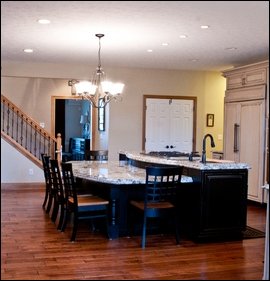 It is common wisdom that in lighting design, glare is to be avoided. After all, if you or your guests are looking directly into a light source, it will hurt your eyes. Moreover, it will contract your irises, which actually makes the room look dimmer. Causing both discomfort and dimness is, of course, the opposite of what lighting design is supposed to do.
It is common wisdom that in lighting design, glare is to be avoided. After all, if you or your guests are looking directly into a light source, it will hurt your eyes. Moreover, it will contract your irises, which actually makes the room look dimmer. Causing both discomfort and dimness is, of course, the opposite of what lighting design is supposed to do.
Nonetheless, there are still some common mistakes that people make that cause unwanted glare both for themselves and for their guests. In this article, I will discuss those common errors and how to fix them.
Bathroom Vanities
Bathroom vanities are one of the most common sources of glare in homes. After all, there are really only two places that you can place your lights: above and on the sides of the mirror. Each of these is problematic in its own way. Lights above you create harsh shadows on your face, aging you significantly by bringing out your wrinkles. They are also terrible for shaving and applying eyeliner, because you have shadows right where you need light.
However, lights on the sides of the mirror can cause glare. Even if glare is in your peripheral vision, it can be uncomfortable and contract your irises. Although this is the correct position for bathroom vanity lighting, but one still must be careful. Make sure that the light source is significantly frosted. This prevents the light from being too harsh.
People Lying Down
Another common mistake is to forget about people who are lying down. By far the most common instance of this is the use of recessed lighting directly over a bathtub, though the problem is common in bedrooms as well. While you may not be looking directly into a light source when you are standing up, you may not have “considered all of the angles”, so to speak.
Instead, use baffles or louvers on recessed lighting that is directly over your bathtub. Baffles will prevent glare except from directly below, while a louver can prevent bathing glare entirely. For lights over beds, make sure that the light source is significantly frosted, so you aren’t blinded while lying down.
Reflections
Finally, people make the mistake of allowing glare, but through reflections. The most common type of this is on countertops and on dining room tables. These surfaces are called “semi-specular”, meaning that you can see a slight reflection in them. It also means that if you are looking at a light source reflected on that surface, you will be receiving glare.
To prevent this, you may need to adjust your kitchen lighting so that people working on countertops are not looking at reflected light sources. Using semi-parabolic reflector bulbs for your under-cabinet lighting can stop any light from shining forward. For overhead kitchen lighting, you may simply need to move the fixture. An option for the dining room is to always eat with a table cloth.
Conclusion
Avoiding glare is an important part of lighting design, but it can really sneak up on you if you aren’t looking in the right place when it is installed. Be sure that your home lighting is both pleasant and illuminating, rather than unpleasant and blinding.
About the Author: Daniel Bader, Ph.D., is the editor and primary author of Home Lighting Design, a website designed to make lighting design information accessible for homeowners.